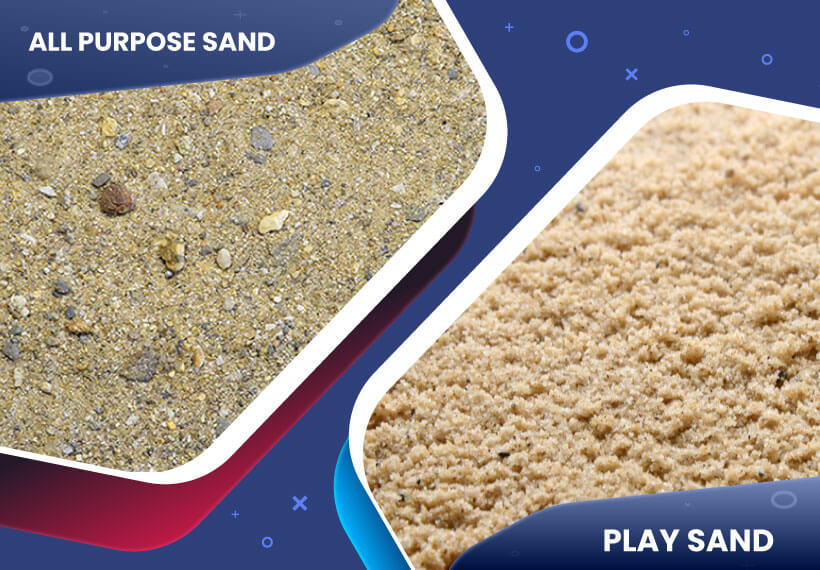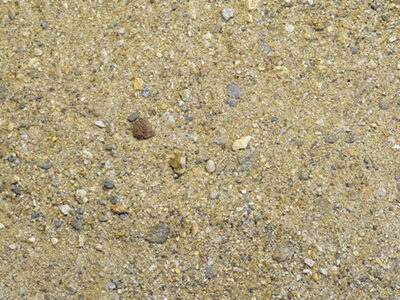Differences Between All Purpose Sand and Play Sand

Are You Planning on Undertaking a DIY Sand Project or Want to Construct a Sandbox for Your Children? In either instance, two types of sand may come into play: all-purpose and play sand.
Though they might appear similar at first glance, these varieties differ significantly in terms of properties, applications and factors to keep in mind when making your selection decision.
In this article, we’ll take a closer look at these distinctions to help make the decision process simpler for both you and your project!
All-Purpose Sand: What Sets It Apart

What is All Purpose Sand?
All-purpose or coarse sand is a versatile material commonly used in construction and landscaping projects, renowned for its larger grains that provide strong support and drainage capabilities.
Due to its coarser texture, all-purpose sand doesn’t compact well, allowing water to pass through easily.
Composition and Texture
All-purpose sand is a highly versatile product known for its smooth and delicate texture, typically created from a mixture of various grains such as silica, quartz and small fragments of seashells.
This combination produces a pleasing and consistent granulation perfect for numerous applications.
Common Uses
All-purpose sand’s versatility can be seen through its many uses – masonry work and construction projects to filling in gaps between pavers – are testament to this fact.
It can provide stability when compacted easily, and its fine texture also provides an ideal base for bricklaying or paver installation.
Pros and Cons of All-Purpose Sand
Pros
Versatility: All-purpose sand lives up to its name by being extremely versatile; its composition and texture allow it to fit many uses, from construction projects to landscaping tasks.
Stability: All-purpose sand is well known for its strength; when compacted properly, it provides a solid base to build structures such as pavers, bricks and stones.
Drainage: Due to their granular composition, our gravel can help ensure effective drainage, preventing excess water accumulation that could lead to erosion or flooding.
Cost-Effective: All-purpose sand is often more cost-effective when compared with speciality varieties, making it a good option for larger projects.
Availability: Sand for general and specific uses is widely available across hardware stores and garden centres, making it easily accessible for DIY enthusiasts and professionals.
Cons
Texture: While all-purpose sand may be versatile, its texture might not be as fine and smooth as some other varieties; this could impact specific projects’ aesthetics.
Not Child-Friendly: All-purpose sand may not be an ideal choice for play areas like sandboxes due to its coarser texture. Play sand is often safer and more enjoyable in such applications.
Limited Aesthetics: If your goal is to create an elegant or polished appearance in your project, all-purpose sand’s slightly rough texture may not be ideal for creating this effect.
Specific Applications: While general-purpose sand may work for most projects, specific uses might demand finer grains or unique properties that this all-purpose variety cannot fulfil.
Maintenance: Sand-filled all-purpose areas may require frequent sifting and levelling to keep a uniform surface, especially if subjected to intensive usage.
Play Sand: Where Fun Meets Safety

What is Play Sand?
Play sand, on the other hand, is specifically tailored for recreational use in playgrounds and sandboxes.
Its finer texture and softer consistency provide children with a more enjoyable play experience while remaining safe for their development.
All-purpose sand can also contain impurities, which must be processed to ensure its safety for play sand use.
Characteristics and Feel
Play sand is explicitly tailored for an enjoyable tactile experience, featuring finer grains that feel silkier upon touching them and are free from impurities that could harm young ones.
Its processing ensures this sand remains free from contamination that could compromise children’s well-being.
Intended Uses
Play sand is designed for recreational purposes, offering children safe and enjoyable play times with no toxic substances.
Thanks to its delicate texture and low risk of contamination, it makes a perfect material for creating sandboxes, playgrounds and other play spaces for them.
Pros and Cons of Play Sand
Pros
Safety: One of the main draws to play sand is its safety features.
Play sand is carefully processed to remove impurities that could potentially harm children and ensures it’s free from toxic materials that could pose risks.
Fine Texture: Play sand is known for its fine, velvety texture that’s soft to the touch, making it highly appealing for tactile play experiences.
Children enjoy running their fingers across its smooth grains.
Recreational Value: Play sand was explicitly developed to be enjoyed recreationally, making it the ideal material for creating sandboxes, playgrounds and other play spaces to stimulate children’s creativity and imagination.
Enjoyable Playtime: Play sand’s inviting texture and safety standards provide children with an engaging and enjoyable play experience, encouraging sensory play while creating positive associations between outdoor activities and positive play experiences.
Peace of Mind: For parents and caregivers alike, play sand offers peace of mind that it is free of contaminants to ensure children can play without experiencing additional risks while they play.
Cons
Limited Applicability: Play sand’s primary function is for recreational play areas, and its fine texture and specific processing may not make it the best choice for construction or landscaping projects that require stability and compaction.
Drainage Issues: Play sand’s fine texture can often hinder optimal drainage in certain situations, leading to pooled water or slower absorption rates.
Less Versatile: While play sand excels at providing entertainment in play areas, its unique properties may limit its use for non-recreational applications.
Aesthetics: Depending on your project, play sand’s fine and uniform texture may not meet aesthetic expectations; some projects could benefit from coarser textures with more variation.
Cost: Due to its production and safety standards, play sand is generally more costly than generic sands; this cost could play into your decision for specific projects.
Key Differences Between All-Purpose Sand and Play Sand
Grain Size and Shape
One of the key differences between all-purpose and play sand types is their grain size and shape; all-purpose tends to feature various grain sizes that create an uneven, rougher feel, while play sand offers consistently fine grains with a smoother feel.
Purity and Safety Considerations
Play sand is processed to meet stringent purity standards, ensuring it’s free from contaminants and safe for children.
In contrast, all-purpose sand may not need intense scrutiny due to its diverse applications.
Projects and Play Areas
Decisions between all-purpose sand and play sand depend heavily on their intended usage.
When working on construction projects or seeking a stable base for recreational activities such as children’s play areas and recreational use, all-purpose sand may be more beneficial; on the other hand, play sand may provide safer and more enjoyable alternatives.
Choosing the Right Sand for Your Project
DIY Projects and Landscaping
If your project involves construction, masonry or filling gaps with fillers, then all-purpose sand should be your go-to material.
Its durability and stability make all-purpose sand suitable for this use; just remember to compact it appropriately for optimal results!
Children’s Play Areas
Play sand is the go-to material when creating an indoor play space for kids, offering fine texture and safety features that allow children to freely explore their creativity while offering parents peace of mind.
Mixing and Substituting Sands: Is It Advisable?
Though mixing different sand types is possible, it’s essential to consider their properties and intended use. A mixture of sands may provide the characteristics needed for specific projects.
Maintaining and Caring for Sand-Filled Areas
All-purpose and play sand require regular upkeep to remain clean and safe for play or daily use. Sifting, clearing away debris, and maintaining drainage systems are crucial steps toward prolonging their useful life in any space filled with sand-filled holes.
Environmental Impact and Sustainability
Think carefully about the environmental consequences when selecting your sand source, and consider recycling or repurposing any excess sand whenever possible.
FAQs
Can I use play sand for construction projects?
Play sand’s fine texture and lack of stability render it less suitable for construction purposes; therefore, it should only be used recreationally.
Is all-purpose sand safe for children’s play areas?
Though all-purpose sand can be used, play sand is specifically processed to meet safety standards for children’s play.
What’s the main advantage of all-purpose sand?
All-purpose sand’s versatility makes it ideal for various construction and landscaping projects, from concrete pours to landscaping designs.
Can I mix play sand with all-purpose sand?
Remixing sands may be possible; however, you must consider their desired properties for your project before doing so.
How often should I replace the sand in a sandbox?
Regular maintenance is key. Replace any sand that becomes contaminated, compacted too much or loses its desirable texture.
Conclusion
In the world of sand, the differences between all-purpose sand and play sand might be subtle, but they are significant.
Your choice of sand will depend on the nature and purpose of your project or play area.
All-purpose sand should be chosen for construction and landscaping, while play sand is ideal for children’s recreational spaces. By understanding these distinctions, you can ensure your endeavours with sand are successful yet safe and enjoyable!

